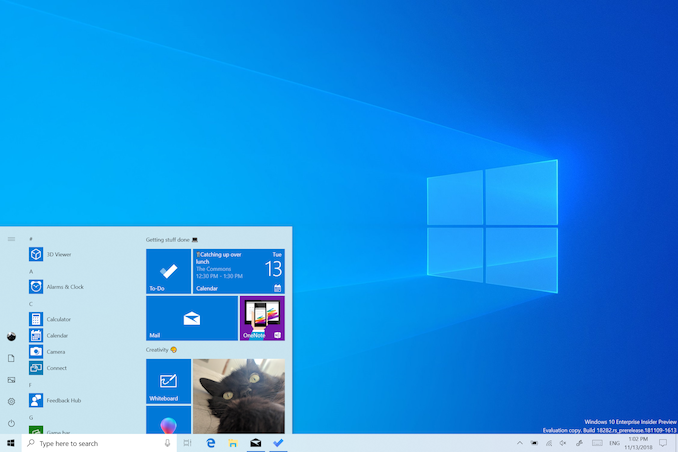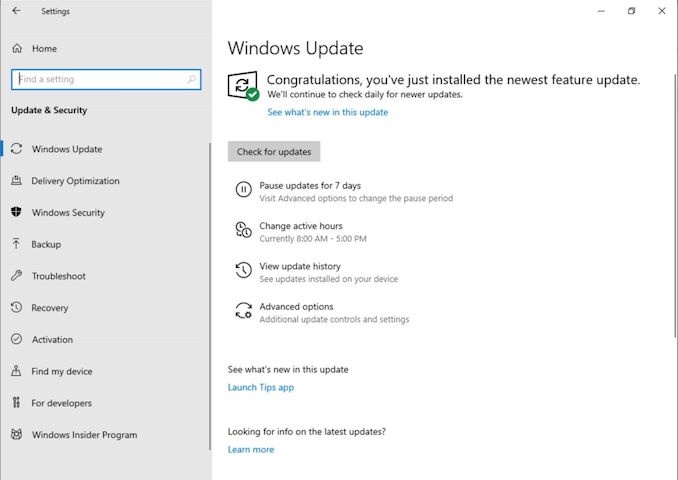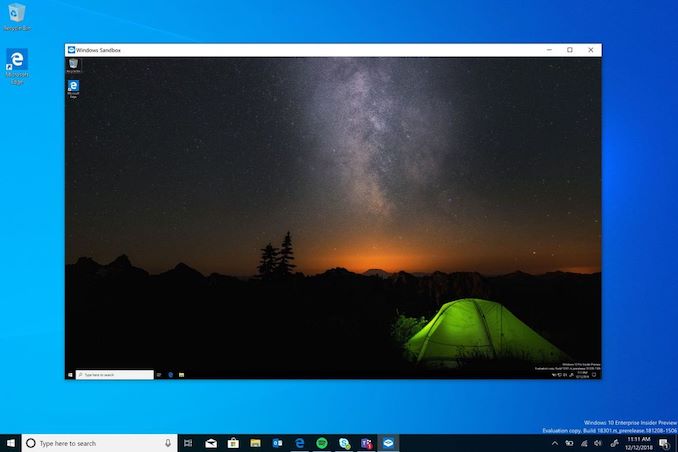A New Approach To Updates: Windows 10 May 2019 Update Available Today
by Brett Howse on May 21, 2019 9:15 PM EST- Posted in
- Operating Systems
- Software
- Microsoft
- Windows 10

For those eager to get the latest and greatest production build of Windows 10; good news. For those who would rather watch from the sidelines until the kinks are worked out; good news. Today Microsoft has officially launched the spring 2019 update for Windows 10, affectionately called the Windows 10 May 2019 Update. There’s a few new features under the hood, but the biggest change to Windows 10 this time is not a new feature you may or may not use, but instead a new approach to updates. And, after almost four years of users not being in control, Microsoft has put the control back in the hands of the people using their OS. Finally.
I’m not going to pine on about days gone past, but one of the biggest changes to Windows 10 when it launched was that the update system was going to be better. Improved. More reliable. Except it wasn’t. Some changes, such as the cumulative updates, have been a huge relief for people setting up new machines, since they no longer needed to update their computer for several days. An update comes every month which should have everything you need to get you to current in one batch. This was a win for end users. However, Windows 10 also brought about a new idea called feature updates, where occasionally, a new version of Windows would come down the same pipe as a normal update. Assuming everything was well tested, the update should install with little fanfare, but as we know that’s not been the case. Windows is on far too many machines to make any update easy, and Microsoft’s feedback mechanism for update issues was not being monitored as it needed to, which lead to multiple feature updates with enough major problems that even the last update from October is only now being pushed out to some machines.
So today we get Windows 10 1903, or the May 2019 Update, and home users will finally get an option to pause updates even if they are using Windows 10 Home. It’s a small step, but coupled with a very measured rollout, hopefully this will be the smooth update Microsoft has been craving for the last couple of years. For those looking for further transparency, Microsoft has a Windows release health dashboard, which shows the status of current known issues, letting you know ahead of time if you may have an incompatible piece of software or hardware.
There are of course new features as well, since this is in fact a feature update for Windows 10. There’s a new light theme, providing a refreshing look for Windows 10 which pairs nicely with the dark mode that arrived a couple of versions ago. Cortana is no longer part of the search bar, and now lives on its own app icon on the task bar. More default applications can now be removed.
There’s more complex features as well, such as Windows Sandbox, which allows you to run an application in a virtualized container for testing without it having access to the system files. Think of it like Hyper-V, but without the complexity. It’s not as powerful as Hyper-V, but it’s also much easier to set up and use.
There’s a few other features as well that we’ll go through in a more comprehensive article after we’ve had time to dig through some of the new abilities. That being said, updates are now offering fewer and fewer big changes, which makes sense due to the maturity of Windows 10 now. Plus, with the lack of stability, it makes sense to offer less user-facing features that are more stable, rather than continue to offer a multitude of new things that may or may not get used.
For those looking to get a jump-start on the upgrade process, Windows 10 May 2019 Update is currently rollout out via Windows Update where you can just check for updates, and you’ll receive it if your computer doesn’t have any blocking hardware or software. Microsoft is taking a very measured and cautious approach here, which is the right thing to do. For those that don’t want to wait for Windows Update, you can always check out the Windows 10 Download page to get the update right now.
Source: Windows Blog












43 Comments
View All Comments
Spunjji - Wednesday, May 22, 2019 - link
You just demonstrated exactly why they don't want most people doing that. They had a huge amount of trouble with "expert" users disabling updates on Windows XP and 7 for their casual user friends back in the day.Alexvrb - Wednesday, May 22, 2019 - link
Ding ding ding! I've seen it happen too many times. They disable updates for the whole family, oh joy, free botnet machines. But worse yet, I've seen it happen in small offices. A doctor's office, for example.Delaying updates is fine. I think this is a good, balanced approach. Stopping them completely should intentionally be a pain in the butt to deter all the but nuttiest of nuts.
Targon - Thursday, May 23, 2019 - link
Just disable the service and make sure the Upgrade Advisor is removed. Poof, Windows Update is no longer functional. As far as picking which updates you want, since Windows will automatically roll back if an update doesn't work and suspend offering you that update for 30 days, that's not an issue.If your whole point is that you don't want the Intel security mitigations installed due to performance, then you won't want to install any feature or even quality updates for the next 10 years, which is probably how long it will take Intel to actually fix their insecure processor design issues.
cosmotic - Tuesday, May 21, 2019 - link
I love that almost all the big new features are obvious flaws, originally intentionally added, being removed now.uefi - Tuesday, May 21, 2019 - link
"A new approach to updates windows" Really? We could selectively chose individual updates we needed to install since Windows XP; also on Windows 8.1 and 7 too. I wonder if Windows 10 will ever be up to speed with OSes of the past.Carmen00 - Wednesday, May 22, 2019 - link
Some system administrators conflate themselves with operating system designers and security experts. They're often neither of these things, and they often don't see the benefit of installing things like security patches. Install mitigations for Spectre/Meltdown? And incur performance penalties of >3%? That's insanity! Fortunately, the decision can be taken out of their hands.Spunjji - Wednesday, May 22, 2019 - link
Nailed it. "I want everyone else's OS to be broken and insecure by default because I think I'm smarter than everyone else and won't face the consequences"RSAUser - Thursday, May 23, 2019 - link
Fun fact, the W10 May 19 update includes a new Spectre patch that has way lower impact, supposedly now negligible.Drazick - Wednesday, May 22, 2019 - link
I wish they dedicated the next 3-4 releases for only under the hood work:1. Reducing the number of background processes and memory consumption.
2. More modular Windows so user will be able to disable / remove components they don't need and optimize performance.
3. Optimize the IO stack so we'll have Linux like performance.
4. Optimize the File System so we'll have Linux like performance.
5. Ability to remove all pre installed components users doesn't want.
We want to be able to make Windows lean and efficient.
mooninite - Wednesday, May 22, 2019 - link
You should just install Linux.